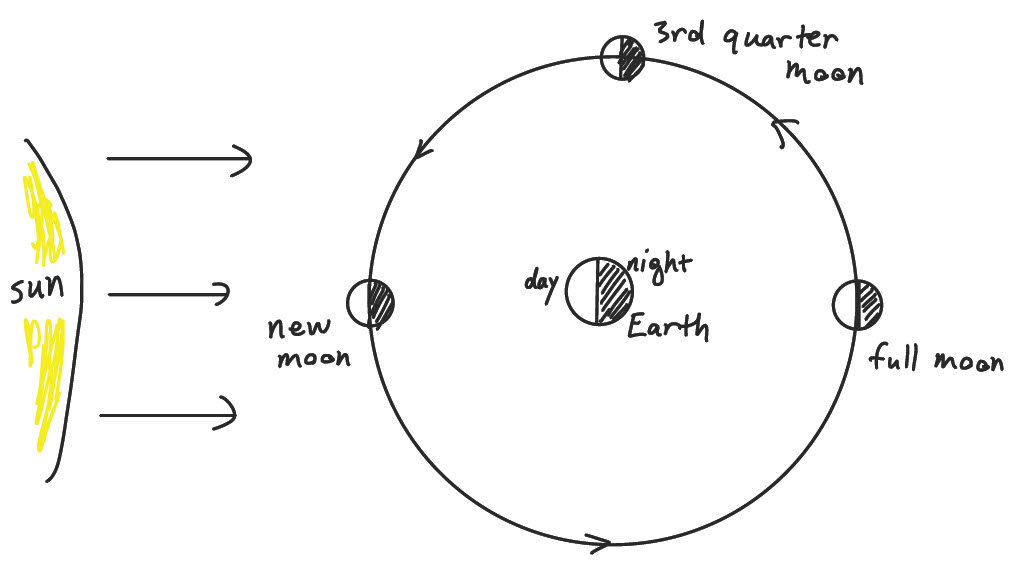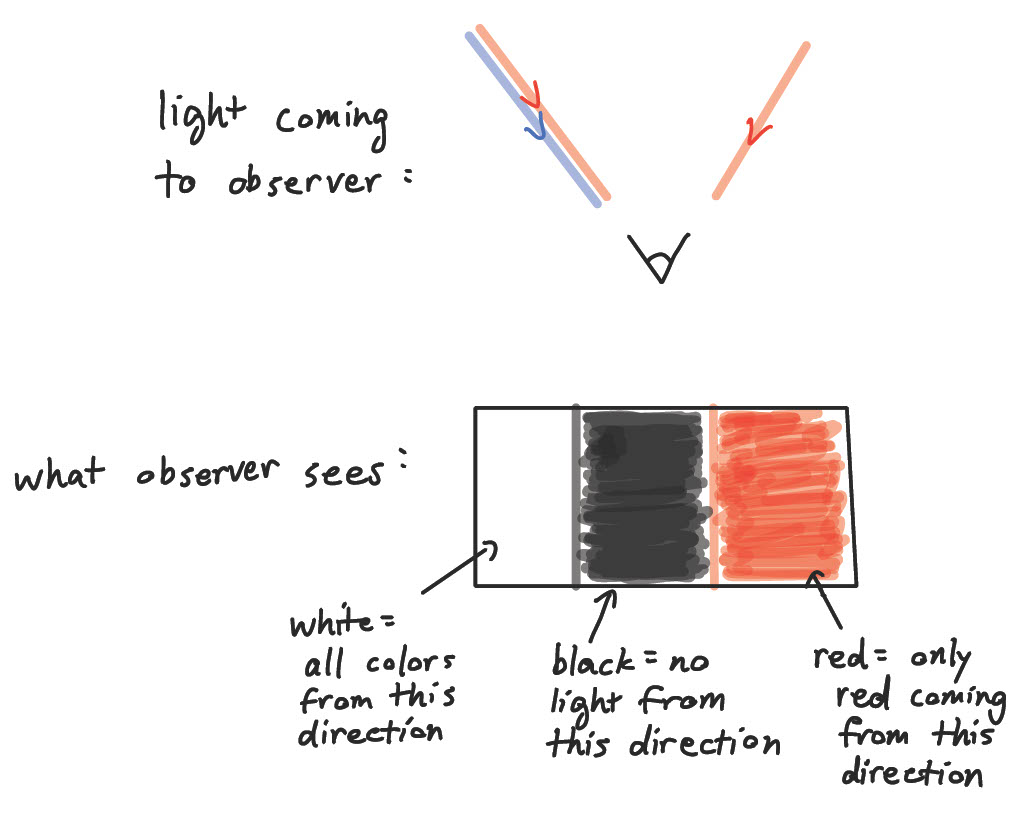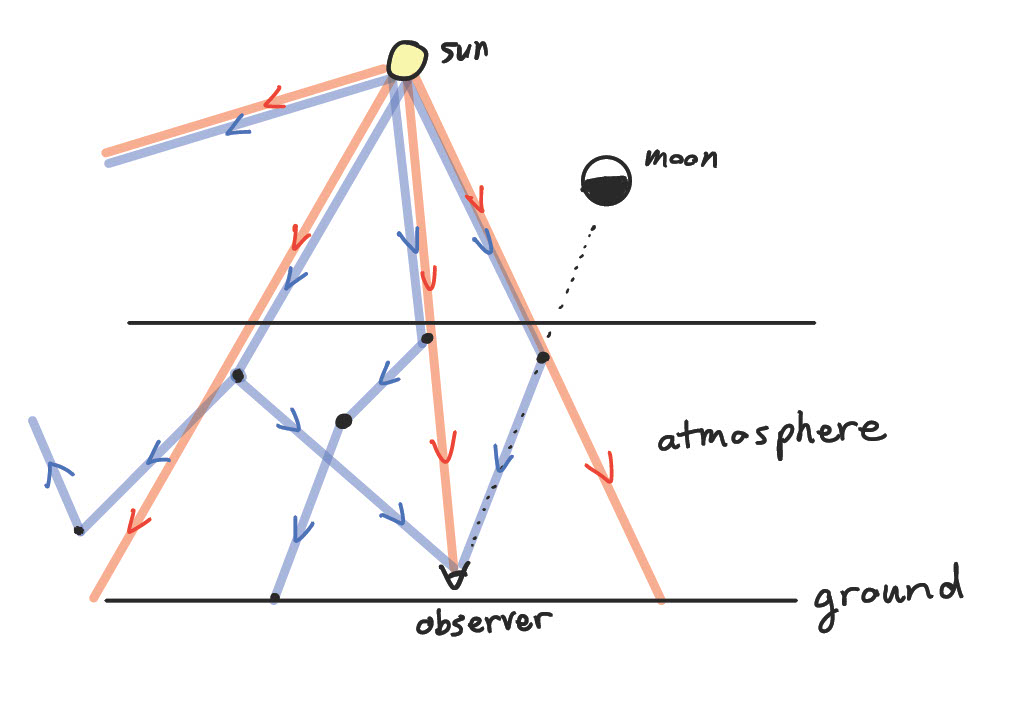A question about new moons
Have you ever wondered why you can’t see a new moon? Maybe you have a rough idea why, but it’s worth thinking it through carefully, because a few very important concepts are involved.
First of all, why is it that the moon looks different as it passes through its different phases each month? You’ll recall that at any time half of the Earth–the half facing the sun–is in daytime, and half of the Earth–the half facing away from the sun–is in nighttime. Someone in space looking at the Earth would see half of the Earth illuminated by sunlight and the other half dark. The same is true of the moon. Regardless of its phase (new, whole, etc.), half of the moon is facing the sun and bright, and half is dark. We see the moon from the Earth, so we see the side of the moon facing the Earth, and we don’t see the side facing away. The side facing us might be the dark (night) side, or it might be the light (day) side, but usually it will be part of the light side and part of the dark side that we see. It depends on where the moon is in its orbit around the Earth. During a new moon, the moon is in the part of its orbit that brings it between the sun and the Earth. Thus, the dark side is facing us. Notice that one looks in the same direction to see the moon as to see the sun. This means the moon is in roughly the same location in the sky as the sun; it is out throughout the day: rising around sunrise and setting around sunset. This configuration, as well as several others, is illustrated below.

You might wonder why the moon doesn’t block the light from the sun and keep it from reaching Earth in the new moon phase. I could not show it on this 2D plot, but the plane of the moon’s orbit about the Earth is slightly inclined compared to the plane of the Earth’s orbit about the sun (the ecliptic). This means the moon should be imagined as bobbing into and out of the image above (imagined to lie in the plane of the ecliptic) as it moves in its orbit. Except in the rare occurance of a solar eclipse, it will be slightly above or below the ecliptic, so it will be in a slightly different location in the sky than the sun.
Okay, so it’s daytime during a new moon, and the dark side of the moon is facing us. Usually, when a black ball is placed in front of me, I see a black circle in my field of vision. Why don’t I see a black circle in the sky if a big black side of the moon is facing me? To understand this, first recall what you know about how vision works. When I look out at the world, what I directly, immediately see is not a collection of distant objects (trees, houses, whatever); what stimulates my vision is light entering my eyes. The field of vision in one of my eyes is essentially a two-dimensional plane of color, like a television screen. Different locations in my field of vision correspond to different directions of incoming light. In the example below, light of all colors is coming to the observer from the left, no light is coming from straight ahead, and red light only is coming to the observer from the right. All colors registers as white; no light from a particular direction registers as black; only red light incoming registers as red. Thus the observer sees white on the left, black straight ahead, and red on the right.

So, to figure out what the sky looks like during a new moon, we just have to figure out what sort of light is coming at the observer in each different direction. The observer will see black only if there is a direction for which no light is incoming. Whether or not there is a black object (an object not emitting or scattering light) nearby only matters if it causes there to be a direction with no incoming light, for example by blocking ambient light coming from behind it, which is the reason we are able to see black objects as such here on Earth.
The source of natural light in the day is the sun. The sun gives off light in all directions, but only a small range of directions are aimed so that they hit the Earth. (Thus, the sun only appears to take up about half a degree in our field of vision.) It gives of light in all colors of the visible spectrum. The peak of the spectrum is in the green, but the spectrum is broad enough that we can treat it as a lot of all the colors, i.e. white, which is how the sun appears in space. When sunlight travels through the atmosphere, the low visible wavelengths (red end of the spectrum) mostly just travel through without scattering or being absorbed, while the short visible wavelengths (blue end of the spectrum) scatter more. Thus, some of the blue sunlight is take out of the rays traveling on straight lines from the sun to the surface, making the sun appear more yellowish, while blue light scatters in all directions. Thus, there is blue light incoming from all directions (except directions coming from downward below the horizon of course), which we see as the bright blue sky. This is shown below.

What do you see if you look in the direction of the new moon? You see scattered blue sunlight, just as you can see from other directions. So blue is what you see.